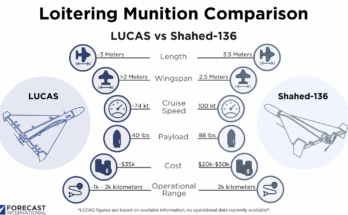Aware of the increasing stresses to its strategic environment, Australia is moving forward with its largest shipbuilding investment since the Second World War. The aim is to replenish and expand the Royal Australian Navy’s (RAN) warship inventory in an undertaking expected to double the size of the fleet.
The government response to an analysis outlining optimal plans for modernization and expansion of the RAN’s surface fleet was released back on February 20, and considering the recently updated National Defence Strategy (NDS) and attendant Integrated Investment Program (IIP) it unquestionably fits with the former’s overarching vision.
While the NDS notes rising security challenges and the need for a whole-of-government and whole-of-nation approach, its main strategic thrust is a “Strategy of Denial” that spans five domains (maritime, land, air, space and cyber) and places particular emphasis on defending the countries northern approaches and projecting power into the Northeast Indian Ocean through maritime Southeast Asia and into the Pacific.
Further, the IIP makes clear the domain of highest priority to the Australian government as maritime capabilities are slated to receive the highest proportional share of investment over the coming decade through 2034 with 38 percent. The next highest, the land domain, will receive just 16 percent.
The new naval buildup plan is the result of an independent analysis – requested by the Albanese government – entitled “Enhanced Lethality Surface Combat Fleet.”
Under the contours of this analysis and the government’s affirmation of its recommendations, several initiatives aimed at providing the Navy with a modernized, larger fleet expanding to 26 Tier 1 and Tier 2 warships are set to be implemented.
The independent analysis took root from a point identified in the country’s 2023 Defence Strategic Review (DSR), which noted the RAN’s previous surface combatant fleet plan was no longer applicable for Australia’s evolving security environment.
With that in mind the analysis team was tasked with identifying the optimal force size, structure, and composition to complement the forthcoming conventionally armed, nuclear-powered submarines set for acquisition under the AUKUS treaty.
The new plan calls for investing an additional AUD11.1 billion ($7.32 billion) over the coming decade to support the fleet renewal and expansion plans, whose costs are estimated at around AUD54.2 billion ($35.6 billion) during that period.
The Enhanced Lethality Surface Combat Fleet review calls for:
- Scrapping previous calls for 12 Tier 1 surface combatants comprised of three Hobart-class air-warfare destroyers and nine Hunter-class frigates (British Type 26 frigate design). Instead, the advisory team recommends nine Tier 1 warships, including the three existing Hobart-class destroyers featuring upgraded Aegis Combat Systems (from Baseline 8 to Baseline 9) and just six Hunter-class frigates procured under a renegotiated Sea 5000 Phase 1 program.
- Acquiring six Large Optionally Crewed Surface Vessels (LOSVs) each featuring 32 Vertical Launching System (VLS) cells and equipped with Aegis Baseline 9 Combat Systems. This procurement would provide additional striking power at a reduced cost and with minimal personnel pressures. It would also ostensibly backfill the three Tier 1 surface combatants scrapped under the Enhanced Lethality Surface Combat Fleet review while adding three additional units, bringing the total Tier 1 fleet to 15 vessels.
- Acquiring at a minimum seven – but more optimally eleven – “Tier 2” warships. These vessels would add a lower-end combatant capability to the future RAN fleet mix. They will serve as a replacement for the eight 1990s-legacy ANZAC-class multirole frigates based on the German TKMS MEKO 200 design. During the acquisition of these ships a to-be-determined number of ANZAC frigates will be put through a planned Transition Capability Assurance Program (TransCAP) upgrade to their undersea warfare and multi-domain strike capabilities.
If enacted as proposed the result for the RAN would be an optimal surface combatant fleet of 26 warships and the overhaul and revitalization of an inventory that the government admits is currently the oldest in the service’s history.
The plan should bolster shipbuilding capability and capacity within the Australian defense industrial landscape via multiple opportunities for workshare, even in instances such as with the proposed ANZAC replacement Tier 2 ships. The steady drumbeat of work is seen as essential to prevent Australia’s naval shipbuilding sector from entering the “Valley of Death“, or boom-and-bust cycle of orders that prevents retention of skilled workers and industrial know-how.
For the Tier 2 acquisition the preference outlined by the independent analysis involves an off-the-shelf procurement to enable faster delivery utilizing proven designs. Four specific candidates were listed, including the TKMS MEKO A-200, the Mogami 30FFM from Japan’s Mitsubishi Heavy Industries, the Daegu FFX Batch II/III from South Korea’s HHI (Hyundai Heavy Industries), and the ALFA3000 from Spain’s Navantia.
Larger questions surrounding the naval buildup plan loom, however, such as whether this ambitious program will be met with the necessary financial backing (much of the estimated AUD54.2 billion remains unfunded).
Another is whether the current government can avoid the big-ticket defense project missteps experienced by its predecessors where on-time delivery within budget is concerned. Examples of these in the naval domain include the RAN’s current Collins-class submarines, Hobart-class air warfare destroyers, and ongoing Arafura offshore patrol vessels (OPVs) program, all of which suffered from various teething problems during the production stage and after delivery. With Australia’s shipbuilding workforce limited the threat of missed delivery deadlines will linger over each acquisition.
Still another issue involves recruitment, training, and retention of sufficient numbers of naval personnel to crew the growing inventory of warships. Even with the optionally crewed LOSVs factored into the mix there will remain a need for more people to operate the growing fleet and manage their emerging technologies.
Finally, there is the question of the timeframe. Much like the U.S. Navy’s shipbuilding plan, under the outlines of the government’s Enhanced Lethality Surface Combat Fleet initiative the RAN’s warship capacity will shrink in the near-term before it starts to grow in the longer term.
The RAN’s first-in-class HMAS Anzac is slated to be retired this year, while the second-in-class frigate HMAS Arunta will follow in 2026. In the meantime, the remainder of the aging ANZAC class will forego their planned “Transcap” comprehensive upgrades, which will save money in the short term but do little to prevent capacity shrinkage.
Further, the new Hunter-class ships – an Australian variant of BAE System’s Type 26 design selected by the government in June 2018 to meet its Project SEA 5000 requirement for anti-submarine warfare frigates – are running years behind schedule and suffering from ballooning costs. The first of these new warships was originally slated to be delivered between 2027-2030; now the earliest handoff date is estimated for 2032.
All of this presents worry when accounting for Australia’s shaky history of managing naval projects.
The risks only increase when considering the ongoing buildup of China’s People’s Liberation Army Navy (PLAN) capabilities and the emphasis being placed by Australia upon deterrence by denial in the country’s northern approaches.
While such deterrence can be applied through early-warning and surveillance assets, cyber-attacks, long-range strike capabilities launched from air, sea or land, the necessity of highly capable naval forces in sufficient numbers represents a huge factor in the overall determent equation.
With the Australian government’s 2023 Defence Strategic Review and 2024 National Defence Review stressing that the country confronts its most challenging strategic environment since the Second World War coupled with a reduced warning time for potential conflict, the disparity between imminent threat and the government’s timeline to acquire the tools to counter this threat is noteworthy.
Though the acquisition of 3-5 U.S.-produced Virginia-class nuclear-powered submarines – followed by the SSN AUKUS variants produced in Australia – will provide significant undersea naval strength to add to the RAN’s toolkit, all of these will arrive from the early 2030s through the 2040s. In other words, downstream from today’s looming threats.
Even the impending rotation of U.S. Navy and U.K. Royal Navy submarine rotations to Perth will provide some help, but these are unlikely to start prior to 2027.
Ultimately the Australian government has presented an ambitious plan that could very well lift RAN capabilities while providing local industry with the steady drumbeat of work necessary to prevent workplace disruptions (a key political consideration for the ruling Labor Party). But the timeline horizons laid out in the plan will require political and financial follow-through, plus a ray of hope that while the shipbuilding program is underway prospective strategic threats do not morph into real – and imminent – ones.
Dan Darling is Forecast International’s director of military and defense markets. In this role, Dan oversees a team of analysts tasked with covering everything from budgeting to weapons systems to defense electronics and military aerospace. Additionally, for over 17 years Dan has, at various times, authored the International Military Markets reports for Europe, Eurasia, the Middle East and the Asia-Pacific region.
Dan's work has been cited in Defense News, Real Clear Defense, Asian Military Review, Al Jazeera, and Financial Express, among others, and he has also contributed commentary to The Diplomat, The National Interest and World Politics Review. He has been quoted in Arabian Business, the Financial Times, Flight International, The New York Times, Bloomberg and National Defense Magazine.
In addition, Dan has made guest appearances on the online radio show Midrats and on The Media Line, as well as The Red Line Podcast, plus media appearances on France 24 and World Is One News (WION).




